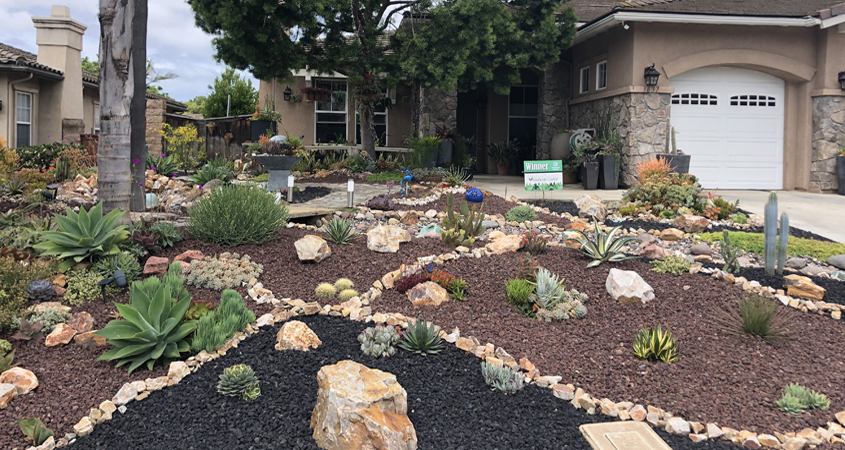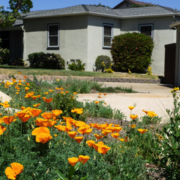Note the height and width of plant species when they mature when choosing plants for new sustainable landscapes. Proper plant placement, taking into account the mature plant’s size, will limit the need for regular pruning, and reduce the amount of maintenance required over time.
While regular pruning and removal of dead plant materials is vital in our region for wildfire prevention, overly aggressive pruning harms plant health and doesn’t allow natural shapes to emerge.
Use the following spacing chart to help you figure out how many plants you need per square foot, based on the mature size of the plants.

Space plants on your landscaping plan at their full mature size, not the size when you first plant them. Graphic: San Diego County Water Authority
Scale your plants at maturity
On your landscaping plan, use circles to note the size of every plant at maturity using a one-inch to four-foot scale. Use colored pencils to denote different water needs of the plants selected. It will make it easier to group plants into their proper irrigation zones (hydrozones).
Wide canopy trees that grow to 20 or 30 feet in diameter will significantly change the landscaping over time. Will this change the microclimates in the future? Consider whether a tree will cover a large section of landscaping with shade that is currently getting full sun. If plants that thrive in full sun are eventually covered in shade, the landscaping may need to be updated in time.
Small but mighty

Planning for the amount of space your new plants will need when fully grown will help your landscape thrive. Photo: Sweetwater Authority
Select the smallest, healthiest plants possible, especially when choosing native plants. Once they are planted in properly prepared soil and watered wisely, small plants establish themselves more vigorously than plants raised in larger containers. Do not plant more than the space allows when the plants mature.
Root depth matters
Take note of the root depth of plants when they are placed into the landscaping. Note the root depth on the plan. Trees will be irrigated less frequently, but for a longer period of time. Groundcovers with shallower roots require more frequent, shorter periods of irrigation. Keep these types of plants on separate hydrozones. Learn more about hydrozones
This article is part of a year-long series inspired by the 71-page Sustainable Landscapes Program guidebook. The Water Authority and its partners also offer other great resources for landscaping upgrades, including free WaterSmart classes at WaterSmartSD.org.






